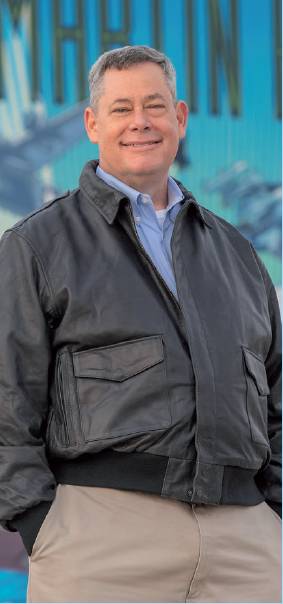Society News
Name: Gregory (Greg) M Ulmer FRAeS, 57.
 Location: Fort Worth, Texas.
Location: Fort Worth, Texas.
Job title: Executive Vice President, Lockheed Martin Aeronautics Company.
What inspired you into aviation? My father was a US Navy aviator. From as early as I can remember, I have always had a dream to work in the aviation field. What is the best thing about your current role? The best thing is being able to work with people who are dedicated to defending our nation and the free world through aviation and aerospace. These committed individuals are using innovation, advanced design, and operational analysis, development, production and sustainment to provide the warfighter with the best products and services possible. This fosters deterrence and, when necessary, dominance.
What made you join the Royal Aeronautical Society? What attracted me to the RAeS was the Society’s legacy and the opportunity it would give me to influence and lead the aerospace, aviation and space domains. It’s because of organisations like the RAeS that there remains an enthusiasm and focus on the continued innovation across these domains, and I was eager to be a part of that.
What do you hope to get out of your membership with the RAeS? I hope that membership and registration will give me a higher profile and level of recognition for my skills than I had before I achieved them. I believe that it will also open up other opportunities for my career and development. As well as progressing through IEng towards CEng, I want to develop as a mentor to help others with their professional registration. Membership of the RAeS will give me access to a wide network of engineers with a huge variety of skills, raising my awareness of the aerospace sector and the opportunities available.
What three items would you take with you to the space station? The three items I would take are my camera, a pencil-and-paper set and a telescope.
What’s your favourite aircraft? Oh, my! How to answer this? When I was a young man, my favourite aircraft were the P-51, P-38 and SR-71. Each was inspiring in its own way. Now, however, the three aircraft that stand out to me are the C-17A, C-130J and F-35 (all three variants). I was involved in the direct testing of the capabilities of the C-17A and the C-130J family of configurations when I was a flight test engineer. So, I have a personal attachment to those two aircraft. As for the F-35, that aircraft is remarkable to me because it provides gamechanging capabilities that challenge the definition of air superiority. It is a force multiplier in terms of situational awareness and integrated sensing and data fusion, and it can share a vast amount of information across an integrated domain.
Who is your biggest inspiration? My biggest inspiration is my father. When I think of my father, several thoughts come to mind. First and foremost was the fact that my father was a naval aviator. His sense of purpose was – and is – aligned with providing for the general welfare and security of our nation. It was always about more than flying aircraft; for him it was about duty and service to our nation. The other thought that comes to mind is his commitment to family and community. At an important point in a successful Navy career, he decided to step away from the military for the sake of his family. My father and mother both earned college degrees while I was in high school. After he completed his degree, my father purchased a hardware store to provide for his family, and he provided for his community by getting involved in many kinds of community service. He was a true servant leader.
Piece of advice for someone looking to enter your field? Consider getting started in a career that enables opportunities across the aviation/aerospace field that provide a diverse career options to seek what resonates with your personal interests. For example, by choosing a career as a flight test engineer, I had the opportunity to work on three programmes (MD-11, C-17 and C-130J) from first flight to certification. During that time, I was exposed to many aviation subjects, such as performance, stability and control, avionics, system performance, propulsion, instrumentation and certification. At the same time, I was exposed to ancillary subjects which were necessary to aviation, including technical application, customer interfacing, written and oral technical communication skills, test discipline, flight safety, risk management, aircraft technical troubleshooting and problem solving.